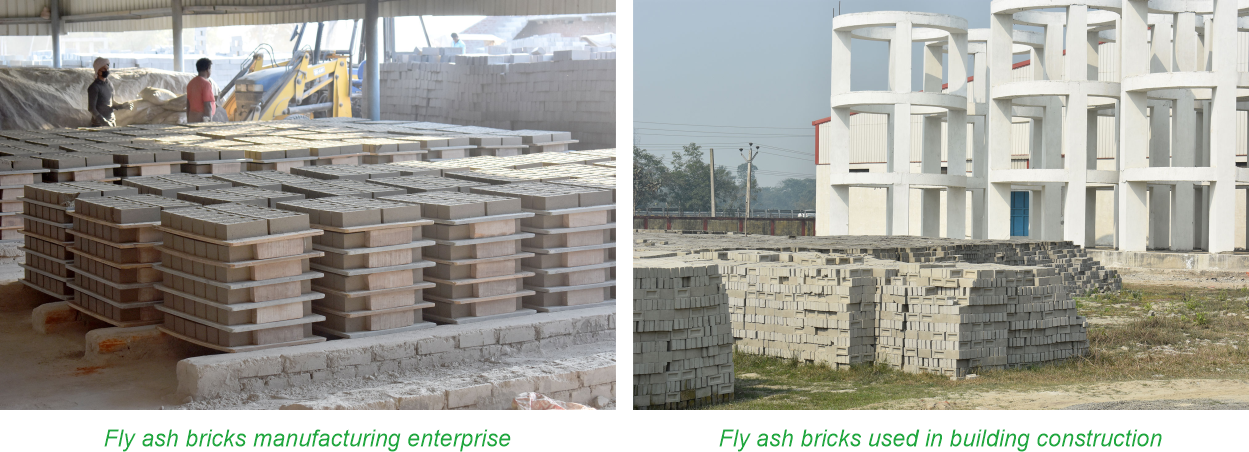|
Brick Making: Shift to Fly Ash Can Help Conserve
Nature in Many Ways
Population explosion, indiscriminate growth, and overexploitation of our precious natural resources to meet the demand of providing more goods and services to every person in the society have led to diminishing the same, and even the remaining ones are exposed to pollution and contamination. Especially during the 19th century, extraction and processing of raw material for mining, energy, machinery, and other purposes increased manifold as compared to the pre-industrial days.
Traditional red-clay bricks have been widely used in the construction sector for centuries. All around the world, clay brick is one of the most commonly used building materials. Its highest concentration is in the Asian market, where India is the second largest manufacturing country after China, indeed (Eil, Li, Baral, et al. 2020; Aswale, 2015). India’s brick industry is entirely unorganised and characterised by many small-scale manufacturers. It has been recognised as a high resource-, energy-intensive, and polluting industry owing to the prevalence of obsolete production technologies. While their clusters are the source point of local air pollution affecting the local population, agriculture, and vegetation, on a global scale, they contribute to climate change.
The fired clay brick industry has a significant environmental footprint. From inception, enormous quantities of fertile topsoil are required to prepare the green bricks, which otherwise could have been utilised for agricultural purposes. It is one of the largest consumers of coal in the country, a source of particulate matter emission, and one of the largest emitters of greenhouse gases such as carbon dioxide.
During the firing stage, a large quantity of coal is required to bake it and convert it into the final product. Also, a traditional kiln occupies a large land area, which is subjected to high temperatures, making the site unfit for agricultural purposes after it is abandoned. The fast depletion of the arable land available in the country is a matter of concern. Due to such adverse environmental effects, it is essential to transition to cleaner and greener alternatives. One of the alternatives in the construction sector is the use of fly ash bricks.
In India, a majority of electricity production is achieved through coal-powered thermal power plants, which is around 75% of the total power generation of the country. According to data from the Ministry of Coal, Government of India, the coal consumption for thermal power generation was 691.084 million tonnes in 2020-21 (GoI, 2021). The coal available to these thermal power plants has a high ash content of 30–45%. With such exorbitant quantities of ash available, it must be utilised correctly; otherwise, it would pose a threat to the environment.

A decade back, fly ash was treated as a waste material worldwide, but now it is considered a resource. With the use of fly ash in the brick, the industry solves the problem of dumping the waste to an extent and provides a reliable solution to environmental pollution. Apart from that, the fly ash bricks do not require any heating for their production, thus cutting down the emissions from coal completely. Fly ash bricks are comparatively lighter and more robust than standard clay bricks. Adopting fly ash in brick manufacturing also helps conserve water quality of the area around the kiln, whereas the traditional kilns lead to the lowering of the water table, poor groundwater recharge, and a high rate of surface runoff and evaporation, which in turn hamper agricultural productivity.
Fly ash bricks production through an energy-free route saves the emissions, while also providing the benefits of the conservation of precious topsoil on one hand and limiting the emissions of greenhouse gases on the other. This would also help in tackling the issue of climate change.
References
Aswale, S. 2015. Brick making in India – history. International Journal of Financial Services Management 4: 11–16. Details available at
https://www.researchgate.net/publication/295387059_BRICK_MAKING_IN_INDIA_-_HISTORY, last accessed on 20 July, 2022 Eil, A., Li, J., Baral, P., and Saikawa, E. 2020. Dirty stacks, high stakes: An overview of brick sector in South Asia. Washington: World Bank. Details available at
https://documents1.worldbank.org/curated/en/685751588227715919/pdf/Dirty-Stacks-High-Stakes-An-Overview-of-Brick-Sector-in-South-Asia.pdf, last accessed on 20 July, 2022
GoI (Government of India). 2021. Despatch of coal to thermal power and coal consumption/off-take during last ten years. New Delhi: Ministry of Coal, GoI. Details available at https://coal.gov.in/sites/default/files/2021-01/Generation-of-Thermal-Power-from-Raw-Coal-and-Coal-Consumption-during-last-ten-years.pdf, last accessed on 20 July, 2022
Sumedha Singh
ssingh2@devalt.org
Naveen Kumar
nkumar1@devalt.org
Back to Contents
|
